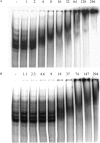Bacillus subtilis aconitase is required for efficient late-sporulation gene expression
- PMID: 16923907
- PMCID: PMC1595401
- DOI: 10.1128/JB.00249-06
Bacillus subtilis aconitase is required for efficient late-sporulation gene expression
Erratum in
- J Bacteriol. 2007 Jul;189(14):5403
Abstract
Bacillus subtilis aconitase, encoded by the citB gene, is homologous to the bifunctional eukaryotic protein IRP-1 (iron regulatory protein 1). Like IRP-1, B. subtilis aconitase is both an enzyme and an RNA binding protein. In an attempt to separate the two activities of aconitase, the C-terminal region of the B. subtilis citB gene product was mutagenized. The resulting strain had high catalytic activity but was defective in sporulation. The defect was at a late stage of sporulation, specifically affecting expression of sigmaK-dependent genes, many of which are important for spore coat assembly and require transcriptional activation by GerE. Accumulation of gerE mRNA and GerE protein was delayed in the aconitase mutant strain. Pure B. subtilis aconitase bound to the 3' untranslated region of gerE mRNA in in vitro gel mobility shift assays, strongly suggesting that aconitase RNA binding activity may stabilize gerE mRNA in order to allow efficient GerE synthesis and proper timing of spore coat assembly.
Figures









Similar articles
-
Effect of site-directed mutagenesis of citB on the expression and activity of Bacillus subtilis aconitase.Mikrobiologiia. 2010 Nov-Dec;79(6):774-8. Mikrobiologiia. 2010. PMID: 21446632
-
Regulation of the transcription of a cluster of Bacillus subtilis spore coat genes.J Mol Biol. 1994 Jul 29;240(5):405-15. doi: 10.1006/jmbi.1994.1456. J Mol Biol. 1994. PMID: 7519271
-
A spore coat protein, CotS, of Bacillus subtilis is synthesized under the regulation of sigmaK and GerE during development and is located in the inner coat layer of spores.J Bacteriol. 1998 Jun;180(11):2968-74. doi: 10.1128/JB.180.11.2968-2974.1998. J Bacteriol. 1998. PMID: 9603889 Free PMC article.
-
[Overview of study on Bacillus subtilis spores].Yakugaku Zasshi. 2013;133(7):783-97. doi: 10.1248/yakushi.13-00143. Yakugaku Zasshi. 2013. PMID: 23811766 Review. Japanese.
-
Spo0M: structure and function beyond regulation of sporulation.Curr Genet. 2018 Feb;64(1):17-23. doi: 10.1007/s00294-017-0718-3. Epub 2017 Jun 2. Curr Genet. 2018. PMID: 28577219 Review.
Cited by
-
Deletion of the aconitase gene in Corynebacterium glutamicum causes strong selection pressure for secondary mutations inactivating citrate synthase.J Bacteriol. 2011 Dec;193(24):6864-73. doi: 10.1128/JB.05465-11. Epub 2011 Oct 7. J Bacteriol. 2011. PMID: 21984793 Free PMC article.
-
Extract from Maize (Zea mays L.): Antibacterial Activity of DIMBOA and Its Derivatives against Ralstonia solanacearum.Molecules. 2016 Oct 19;21(10):1397. doi: 10.3390/molecules21101397. Molecules. 2016. PMID: 27775575 Free PMC article.
-
Moonlighting in Bacillus subtilis: The Small Proteins SR1P and SR7P Regulate the Moonlighting Activity of Glyceraldehyde 3-Phosphate Dehydrogenase A (GapA) and Enolase in RNA Degradation.Microorganisms. 2021 May 12;9(5):1046. doi: 10.3390/microorganisms9051046. Microorganisms. 2021. PMID: 34066298 Free PMC article. Review.
-
Aconitase-mediated posttranscriptional regulation of Helicobacter pylori peptidoglycan deacetylase.J Bacteriol. 2013 Dec;195(23):5316-22. doi: 10.1128/JB.00720-13. Epub 2013 Sep 20. J Bacteriol. 2013. PMID: 24056106 Free PMC article.
-
Evaluating the Potential of Co-supplementation of Zinc and Ferrous Iron Ion for Itaconic Acid Fermentation of Aspergillus terreus.Appl Biochem Biotechnol. 2025 Jul 1. doi: 10.1007/s12010-025-05317-x. Online ahead of print. Appl Biochem Biotechnol. 2025. PMID: 40591109
References
-
- Addess, K. J., J. P. Basilion, R. D. Klausner, T. A. Rouault, and A. Pardi. 1997. Structure and dynamics of the iron responsive element RNA: implications for binding of the RNA by iron regulatory binding proteins. J. Mol. Biol. 274:72-83. - PubMed
-
- Bulteau, A. L., H. A. O'Neill, M. C. Kennedy, M. Ikeda-Saito, G. Isaya, and L. I. Szweda. 2004. Frataxin acts as an iron chaperone protein to modulate mitochondrial aconitase activity. Science 305:242-245. - PubMed
Publication types
MeSH terms
Substances
Grants and funding
LinkOut - more resources
Full Text Sources
Molecular Biology Databases
Research Materials

